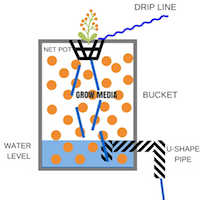 The Dutch bucket is perhaps the most commonly used container for holding plants in an indoor growing system. Tomato, cucumber, eggplant, squash, pepper, and pole bean plants are all commonly grown in the Dutch Bucket system. When growing tomato, eggplant, and pepper plants, plan the spacing of your buckets to allow for at least 4 sq ft per plant.
The Dutch bucket is perhaps the most commonly used container for holding plants in an indoor growing system. Tomato, cucumber, eggplant, squash, pepper, and pole bean plants are all commonly grown in the Dutch Bucket system. When growing tomato, eggplant, and pepper plants, plan the spacing of your buckets to allow for at least 4 sq ft per plant.
Dutch buckets are used extensively throughout Europe and the US, and can be connected easily, allowing hydroponic systems to be scaled to virtually any size needed. The Dutch Bucket is basically a 2.5 gallon bucket with a special drain fitting that maintains a small reserve of nutrient at the bottom. This method is best suited for large, long-term crops such as vine tomatoes, cucumbers and roses. Each bucket is fed nutrient solution independently by a single or double dripper, and it drains through the bucket into a common drain tube made from 1.5 inch PVC pipe. The system’s reservoir is positioned below the level of the drain pipe, and gravity carries the solution back to it. A pump then re-circulates the nutrient solution back to the drippers to start the feeding cycle over again. The buckets are used for both hydroponics and aquaponics, and feature the ability to use a single watering line and a single drainage line for multiple media beds when lined up together.
I like this guy’s approach, using his discarded work buckets. His wife’s filming technique however… (And is she really wife #8??)
